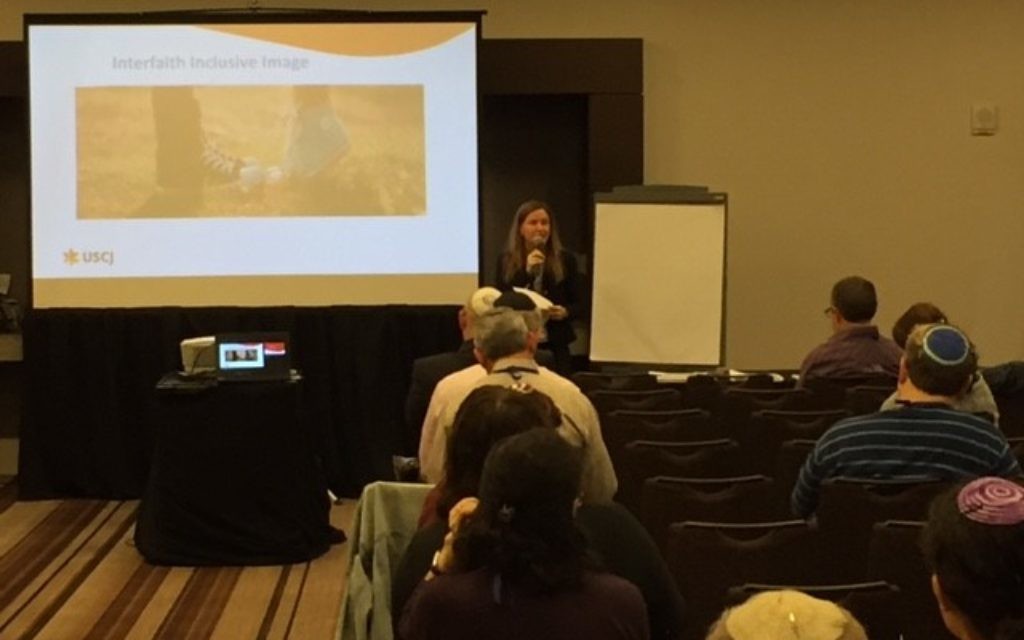USCJ Confronts Identity Issues at Biennial
Congregations' Interfaith concerns don't begin or end under the chuppah.

As Conservative Judaism gained traction in America in the early 1900s, its leaders could not foresee the changes responsible for the challenges facing the movement today.
Back then, Jews were an “other” in American society. But in the mid-20th century, as barriers in housing, employment and education began to fall, Jews (primarily the non-Orthodox) entered the mainstream.
What once seemed improbable — Jews marrying non-Jews, for example — gradually became commonplace.
Get The AJT Newsletter by email and never miss our top stories Free Sign Up
At the biennial of the United Synagogue of Conservative Judaism, those challenges were a prominent theme for the estimated 1,000 congregation leaders, clergy and other interested parties who gathered at the Marriott Marquis in downtown Atlanta for five days.
(Disclosure: The author’s family has historical and current ties to the Conservative movement.)
The struggle to be “an authentic and dynamic Judaism,” a tagline favored by USCJ, remains the same as it was more than a century ago: how to remain faithful to religious laws and tradition while recognizing the realities of life in America.
Take, for example, “Our Clergy Can’t Officiate Your Wedding But …,” the title of a session that put front and center the ban on Conservative rabbis conducting marriages between Jews and non-Jews.
Rabbi Robyn Frisch, the director of Interfaith Family/Philadelphia, and Rabbi Malka Packer-Monroe, the director of Interfaith Family/Atlanta, led 75 to 100 people through such topics as how to (and how not to) identify the spouse who is not Jewish according to halacha (which relies on matrilineal descent) or is of a different faith or has no faith.
Shiksa (a woman who is not Jewish) and goy (a gentile) are obvious examples of terms that might provoke sensitivities, but so might non-Jew, half-Jew or patrilineal Jew, Rabbi Packer-Monroe said.
Just as USCJ recently decided that individual congregations — USCJ’s preferred term is kehillot (communities) — can determine what membership status to offer non-Jewish spouses and partners, those congregations will decide for themselves what language to use.
“We don’t have a great vocabulary for this,” Rabbi Packer-Monroe said. “That is the challenge. How do we talk about these people in our community who are loving, supportive partners?”
She said a relatively small fraction of Jewish families today fit an archetype of a mother and father, neither divorced and both born Jewish, with two to three children born to those parents and not adopted.
Congregations must gauge how to portray themselves internally and externally, including the member images selected for its website and printed materials. “How do you show an interfaith family without saying it’s an interfaith family?” Rabbi Frisch asked.
Issues raised by the moderators, and increasingly by the audience, ranged from coming-of-age ceremonies for the children of interfaith families to the possible roles of non-Jewish members on synagogue boards and committees, and from retaining a non-Jewish member after a Jewish spouse dies to the burial of non-Jewish spouses in congregation cemeteries.
When an audience member raised the issue of conversion, Rabbi Packer-Monroe cautioned that a non-Jewish partner might not wish to convert and thus surrender a cherished piece of identity and that being a supportive partner (including raising children in Judaism) does not require being Jewish.
Rabbi Frisch suggested considering a strategy that says, “The opportunity is there, but the obligation to convert is not.”
Identity also was the focus of a session featuring Yehuda Kurtzer, the president of the Shalom Hartman Institute of North America.
The “affluence, influence, power and privilege” of today’s American Jews enable them “to be power forces for change in a society that needs help,” Kurtzer said.
Yet these opportunities come as “issues of identity and boundaries” challenge Conservative Judaism’s rabbinate and congregations and the lives of its adherents. The movement’s share of American Jewish households declined from 38 percent in 1990 to 18 percent in the 2013 Pew Research Center study of American Jews and to 14 percent in the Public Religion Research Institute report on “America’s Changing Religious Identity,” released in September.
“The pace of change is more than many of us Jews can handle,” even as Conservative Judaism consider whether and what changes might be necessary. “If things slow, changes can be introduced to preserve and adapt,” Kurtzer said.
He drew a distinction between America, where there has been a “radical proliferation of forms of Jewish identity,” and Israel, where the lines between religious and secular are being more rigidly drawn.
While Judaism as a religion is based on the worship of G-d, American Jews as individuals are creating their own definitions of what it means to be Jewish, Kurtzer said.
“We live in a time when there is increasing skepticism about boundaries in general,” he said.




comments